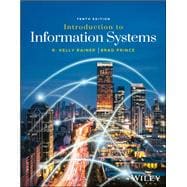PREFACE iii
1 Introduction to
Information Systems 1
Opening Case 1
Introduction 4
1.1 Why Should I Study Information Systems? 4
1.2 Overview of Computer-Based
Information
Systems 12
1.3 How Does IT Impact Organizations? 20
1.4 Importance of Information Systems
to Society 25
Summary 30
Chapter Glossary 30
Discussion Questions 31
Problem-Solving
Activities 32
Closing Case 32
2 Organizational Strategy,
Competitive Advantage,
and Information Systems 34
Opening Case 34
Introduction 37
2.1 Business Processes 38
2.2 Business Process Improvement, Business
Process Reengineering, and Business Process
Management 45
2.3 Business Pressures, Organizational Responses, and
Information Technology Support 49
2.4 Competitive Advantage and Strategic Information
Systems 59
Summary 66
Chapter Glossary 67
Discussion Questions 68
Problem-Solving
Activities 68
Closing Case 68
3 Ethics and Privacy 71
Opening Case 71
Introduction 72
3.1 Ethical Issues 73
3.2 Privacy 78
Summary 88
Chapter Glossary 88
Discussion Questions 89
Problem-Solving
Activities 89
Closing Case 90
4 Information Security 92
Opening Case 92
Introduction 94
4.1 Introduction to Information Security 95
4.2 Unintentional Threats to Information Systems 97
4.3 Deliberate Threats to Information Systems 100
4.4 What Organizations Are Doing to Protect
Information Resources 108
4.5 Information Security Controls 110
Summary 120
Chapter Glossary 121
Discussion Questions 122
Problem-Solving
Activities 122
Closing Case 123
5 Data and Knowledge
Management 125
Opening Case 125
Introduction 127
5.1 Managing Data 128
5.2 The Database Approach 132
5.3 Big Data 136
5.4 Data Warehouses and Data Marts 142
5.5 Knowledge Management 151
5.6 Appendix: Fundamentals of Relational Database
Operations 153
Summary 161
Chapter Glossary 162
Discussion Questions 163
Problem-Solving
Activities 164
Closing Case 164
6 Telecommunications
and Networking 166
Opening Case 166
Introduction 168
6.1 What Is a Computer Network? 169
6.2 Network Fundamentals 172
6.3 The Internet and the World Wide Web 176
6.4 Network Applications: Discovery 183
x CONTENTS
6.5 Network Applications: Communication 186
6.6 Network Applications: Collaboration 188
6.7 Network Applications: Educational 192
Summary 194
Chapter Glossary 195
Discussion Questions 196
Problem-Solving
Activities 197
Closing Case 198
7 E-Business
and E-Commerce
200
Opening Case 200
Introduction 202
7.1 Overview of E-Business
and E-Commerce
203
7.2 Business-to-
Consumer
(B2C) Electronic
Commerce 211
7.3 Business-to-
Business
(B2B)
Electronic Commerce 222
7.4 Ethical and Legal Issues in E-Business
226
Summary 231
Chapter Glossary 232
Discussion Questions 233
Problem-Solving
Activities 233
Closing Case 234
8 Wireless, Mobile Computing,
and Mobile Commerce 236
Opening Case 236
Introduction 238
8.1 Wireless Technologies 239
8.2 Wireless Computer Networks and Internet
Access 248
8.3 Mobile Computing and Mobile Commerce 254
8.4 The Internet of Things 259
Summary 264
Chapter Glossary 265
Discussion Questions 265
Problem-Solving
Activities 266
Closing Case 266
9 Social Computing 268
Opening Case 268
Introduction 270
9.1 Web 2.0 272
9.2 Fundamentals of Social Computing in
Business 280
9.3 Social Computing in Business: Shopping 284
9.4 Social Computing in Business: Marketing 289
9.5 Social Computing in Business: Customer
Relationship Management 293
9.6 Social Computing in Business: Human Resource
Management 294
Summary 297
Chapter Glossary 298
Discussion Questions 298
Problem-Solving
Activities 299
Closing Case 299
10 Information Systems
within the Organization 302
Opening Case 302
Introduction 303
10.1 Transaction Processing Systems 304
10.2 Functional Area Information Systems 305
10.3 Enterprise Resource Planning Systems 312
10.4 ERP Support for Business Processes 318
Summary 323
Chapter Glossary 324
Discussion Questions 324
Problem-Solving
Activities 324
Closing Case 325
11 Customer Relationship
Management and Supply
Chain Management 326
Opening Case 326
Introduction 327
11.1 Defining Customer Relationship Management 328
11.2 Operational Customer Relationship Management
Systems 332
11.3 Other Types of Customer Relationship
Management Systems 336
11.4 Supply Chains 339
11.5 Supply Chain Management 341
11.6 Information Technology Support for Supply Chain
Management 348
Summary 354
Chapter Glossary 355
Discussion Questions 356
Problem-Solving
Activities 357
Closing Case 357
12 Business Analytics 360
Opening Case 360
Introduction 362
12.1 Managers and Decision Making 363
12.2 The Business Analytics Process 366
12.3 Descriptive Analytics 370
12.4 Predictive Analytics 375
12.5 Prescriptive Analytics 383
12.6 Presentation Tools 386
Summary 390
Chapter Glossary 390
Discussion Questions 391
Problem-Solving Activities 391
Closing Case 392
13 Acquiring Information Systems
and Applications 395
Opening Case 395
Introduction 396
13.1 Planning for and Justifying IT Applications 397
13.2 Strategies for Acquiring IT Applications 400
13.3 Traditional Systems Development Life Cycle 404
13.4 Alternative Methods and Tools for Systems
Development 409
Summary 415
Chapter Glossary 417
Discussion Questions 418
Problem-Solving
Activities 418
Closing Case 418
14 Artificial Intelligence 420
Opening Case 420
14.1 Introduction to Artificial Intelligence 422
14.2 Machine Learning and Deep Learning 424
14.3 Neural Networks 430
14.4 Artificial Intelligence Applications 434
14.5 Artificial Intelligence in the Functional Areas 437
14.6 Appendix 453
Summary 458
Chapter Glossary 458
Discussion Questions 459
Problem-Solving
Activities 459
Closing Case 459
Technology Guide 1 Hardware 461
Introduction 461
TG 1.1 Introduction to Hardware 462
TG 1.2 Strategic Hardware Issues 462
TG 1.3 Computer Hierarchy 462
TG 1.4 Input and Output Technologies 464
TG 1.5 The Central Processing Unit 471
Summary 477
Technology Guide Glossary 477
Discussion Questions 478
Problem-Solving Activities 478
Technology Guide 2 Software 479
Introduction 479
TG 2.1 Software Issues 480
TG 2.2 Systems Software 482
TG 2.3 Application Software 483
Summary 485
Technology Guide Glossary 486
Discussion Questions 486
Problem-Solving
Activities 486
Technology Guide 3 Cloud
Computing 487
TG 3.1 Introduction 487
TG 3.2 The Basics of Cloud Computing 489
TG 3.3 Different Types of Clouds 493
TG 3.4 Cloud Computing Services 496
TG 3.5 The Benefits of Cloud Computing 500
TG 3.6 Concerns and Risks with Cloud Computing 503
TG 3.7 The “Big Three” Cloud Computing Vendors 506
TG 3.8 Web Services and Service-Oriented
Architecture 509
Summary 512
Technology Guide Glossary 513
Discussion Questions 514
Problem-Solving
Activities 514
Appendix Apply the Concept
Activities 515
COMPANY INDEX 565
SUBJECT INDEX 573









